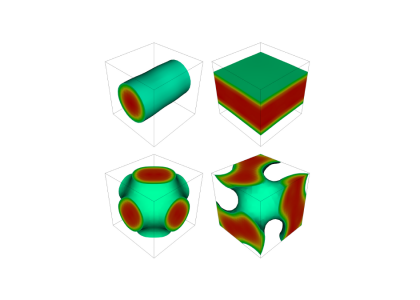Nuclear Pasta Reveals the Mystery Inside Neutron Stars
Researcher Bastian Schütrumpf recently worked with Michigan State University’s Institute for Cyber-Enabled Research (ICER) to simulate nuclear pasta, a unique phase of nuclear matter formed inside neutron stars.

“The geometry of the structures resembles various types of pasta, like spaghetti, lasagna, and gnocchi,” Schütrumpf said. “For my research, it’s important to know what phases the pasta have.”
A neutron star is relatively small on the astronomical scale—having a radius of only about 12 kilometers—with nuclear pasta primarily located about 100 meters deep, within the star’s inner crust. It is also reasonable to assume that the system is periodic, exponentially increasing the amount of information in the model. Because of the vast amounts of data required to create quantum-mechanical models of nuclear pasta, it is only feasible to simulate a small part of this formation, so limitations are put in place.
“In our calculations, we introduced twist-averaged boundary conditions, lowering finite-size effects drastically,” Schütrumpf said. “By performing these calculations in volumes that are 52 orders of magnitude smaller, we can extract reliable results that give us insights into a variety of very complex pasta shapes.”
The ultra-compact nature of neutron stars creates an unusual competition between the electrostatic and the nuclear forces. This competition allows for the complex neutron and protons assemblies that constitute nuclear pasta phases. These pasta phases represent a unique environment that’s not present on Earth and cannot be recreated in the laboratory.
“By studying them, we can learn a variety of things, including how the core rotates in relation to crust,” Schütrumpf said. “Our research can help, for instance, to explain why neutron stars rotate fast.”
Schütrumpf came to MSU in fall 2014 to join the nuclear theory group of Professor Witek Nazarewicz at the university’s Facility for Rare Isotope Beams (FRIB). Schütrumpf works on different applications of Nuclear Density Functional Theory, including nuclear pasta. This type of research necessitates high-performance computing systems, which led him to ICER and the MSU High Performance Computing Center (HPCC).
“MSU’s high-performance computer enabled us to make our calculations, which needed to run several CPUs on up to 64 nodes,” Schütrumpf said. “When you’re making 64 parallel calculations for each shape like we were, it gets very expensive. The HPCC worked perfectly for us.”
Schütrumpf said he was happy with his experience with ICER, and says he looks forward to continuing to work with its team.
“The ICER team has been very helpful,” Schütrumpf said. “They were even able to help me modify the program I was using to better accommodate my research.”
